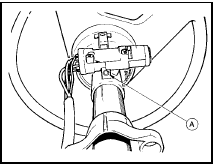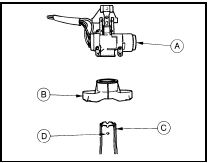Steering column lock - removal and refitting
Note: For ignition switch removal see Chapter 5. A new shear-bolt will be required on refitting.
Removal
1 To remove the ignition switch/column lock,
the shear-head bolt must be drilled out.
2 Access for drilling can only be obtained if the steering column is lowered. To do this, remove the shrouds from the upper end of the column by extracting the fixing screws.
Disconnect the battery earth lead.
3 Unscrew the bonnet release lever mounting screw and position the lever to one side.
4 Disconnect the steering column clamps.
The lower one is of bolt and nut type, while the upper one is of stud and nut design.
5 Lower the shaft/column carefully until the steering wheel rests on the seat cushion.
6 Centre-punch the end of the shear-bolt which secures the steering column lock and then drill it out. Remove the ignition switch/column lock (see illustrations).

24.6a Steering column lock assembly shear bolt (A) Pre-1986 version shown

24.6b Steering column lock components - pre-1986 models
A Lock housing
B Upper clamp
C Column tube
D Shear bolt
indentation
Refitting 7 When refitting the lock, check for correct operation and then tighten the new shear-bolt securing bolt until its head breaks off.
8 Raise the steering column and reconnect the clamps.
9 Refit the bonnet release lever and the column shrouds.
10 Reconnect the battery.
See also:
Contact breaker points adjustment - models with contact breaker
distributor (Every 6000 miles or 6 months)
1 Spring back the retaining clips or undo the
screws as appropriate and lift off the
distributor cap.
2 Withdraw the rotor arm from the distributor
shaft.
3 Using a screwdriver, gently prise the
...
Coolant renewal (Every 24 000 miles or 2 Years)
Cooling system draining
1 It is preferable to drain the system when the
coolant is cold. If it must be drained when hot,
release the pressure cap on the thermostat
housing (or expansion tank on la ...
Weber 2V carburettor - adjustment
Idle speed and mixture
adjustment
1 Refer to Chapter 1.
Fast idle speed (XR3 models)
2 Remove the air cleaner as described in
Section 2.
3 Have the engine at normal operating
temperature, with ...
